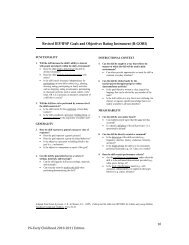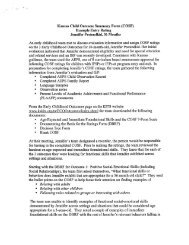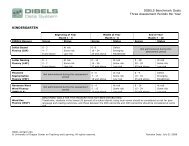gei teacher observation checklist for occupational therapy - Usd 333
gei teacher observation checklist for occupational therapy - Usd 333
gei teacher observation checklist for occupational therapy - Usd 333
Create successful ePaper yourself
Turn your PDF publications into a flip-book with our unique Google optimized e-Paper software.
What do I do <strong>for</strong> the child who keeps the fingers right on the pencil lead<br />
when writing?<br />
Encourage the child to learn what it feels like to hold the pencil up on the paint,<br />
instead of near the lead: put a rubber band around the pencil about one inch above<br />
where the paint begins and prompt the child to keep his/her fingers on, or just above<br />
the rubber band.<br />
Encourage a reward program, but make it sporadic so the child does not become<br />
dependent upon the reward.<br />
Dots, or other marks, on the pencil barrel to cue the child as top proper finger<br />
placement will also help.<br />
Why is it important to have children write large at first?<br />
This encourages hand muscle control <strong>for</strong> fine motor and visual perceptual skills.<br />
The child is more able to experiment and establish appropriate patterns <strong>for</strong> when it<br />
comes to written communication.<br />
What can I do <strong>for</strong> the child who writes very darkly, like charcoal?<br />
Have the child play “ghost writing.” The child writes a word lightly on the paper and<br />
then has to erase it without leaving marks. The child wins if they can do this. Talk<br />
about “lifting the pencil tip off the paper” as the child writes.<br />
Set up a reward program. If the child writes too darkly, give points <strong>for</strong> every letter that<br />
is written lightly with more appropriate pressure on the paper. Initially, <strong>for</strong> five points<br />
you give a sticker. As the child improves, you increase the number of points needed<br />
to get a sticker to 10, 15, 20, etc. You can also increase the volume of writing needed<br />
to get a sticker or reward.<br />
What can I do <strong>for</strong> the child who writes too lightly and doesn’t press on the<br />
paper?<br />
Have the child use a larger pencil, this will build confidence that the pencil will not slip<br />
out of their hands.<br />
Try wrapping a rubber band about one inch up from where the paint begins and the<br />
child can place his/her fingers on the rubber band to prevent slippage.<br />
Pencil grips may be used, but not depended upon if you can help it.<br />
Have the child rub a crayon hard on a piece of paper to make layers of wax or<br />
completely cover a picture so that it can’t be seen.<br />
A reward program may also be set up.<br />
How do I help the child who doesn’t leave spaces between words?<br />
Have the child say the letter right be<strong>for</strong>e he/she writes them. Then when they get to a<br />
space have them say “space.”<br />
Have the child use their finger or penny <strong>for</strong> a spacer.<br />
GEI 9 OT











